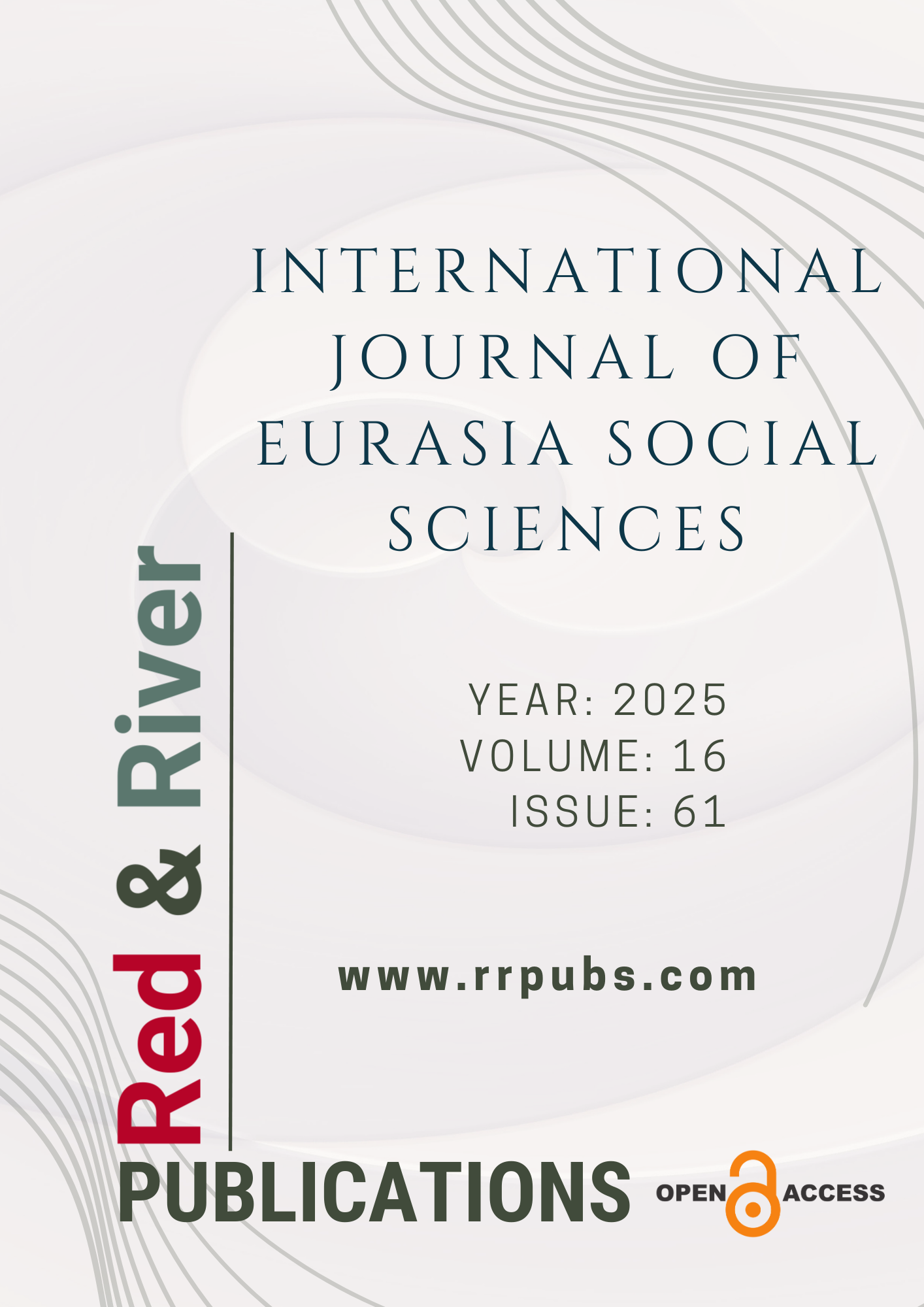Spor bilimleri öğrencilerinde yeme davranışlarının belirleyicileri: Kronotip, cinsiyet ve fiziksel aktivite düzeyi
DOI:
https://doi.org/10.70736/ijoess.1995Anahtar Kelimeler:
Yeme Davranışı- Kronotip- Fiziksel Aktivite Düzeyi- Spor Bilimleri- ÖğrenciÖzet
Bu çalışma, spor bilimleri öğrencilerinde kronotip, cinsiyet ve fiziksel aktivite düzeyinin yeme davranışları üzerindeki etkisini incelemek amacıyla kesitsel ve ilişkisel bir desende tasarlanmıştır. Araştırma, 18-24 yaş aralığındaki 124’ü erkek, 80’i kadın olmak üzere toplam 204 öğrenci ile yürütülmüştür. Veriler, Kişisel Bilgi Formu, Sabahçıl-Akşamcıl Anketi (MEQ), Yeme Farkındalığı Ölçeği (YFÖ-30) ve Uluslararası Fiziksel Aktivite Ölçeği-Kısa Form (UFAA-KF) aracılığıyla toplanmış; istatistiksel analizlerde bağımsız örneklem t-testi, Ki-kare, tek yönlü ANOVA ve Pearson korelasyon testleri kullanılmıştır. Çalışmada; kadın öğrenciler duygusal yeme boyutunda erkeklere kıyasla anlamlı düzeyde yüksek puan alırken (p<0,01), erkek öğrenciler yeme kontrolünde daha yüksek performans göstermiştir (p<0,05). Kronotip grupları karşılaştırıldığında, ara tipin akşamcıl tipe göre duygusal yeme, yeme kontrolü ve enterferans boyutlarında avantajlı olduğu; sabahçıl tipin ise yeme disiplininde daha üstün olduğu tespit edilmiştir. Fiziksel aktivite düzeyi arttıkça duygusal yeme azalmış (p=0,001) ve yeme disiplini artmıştır. Ayrıca, zayıf BMI grubundaki öğrenciler, düşünmeden yeme ve yeme kontrolü alt boyutlarında anlamlı derecede düşük puanlar almıştır (p<0,05). Sonuç olarak, kronotip, cinsiyet ve fiziksel aktivitenin yeme davranışları üzerinde karmaşık ve birbiriyle ilişkili etkileri olduğu belirlenmiş; bu faktörlerin kişiselleştirilmiş beslenme ve yaşam tarzı müdahalelerinde dikkate alınmasının önemi vurgulanmıştır.
Referanslar
Almoosawi, S., Vingeliene, S., Karagounis, L. G., & Pot, G. K. (2018). Chronotype: Implications for epidemiologic studies on chrono-nutrition and cardiometabolic health. Advances in Nutrition, 9(1), 69–81. https://doi.org/10.1093/advances/nmy070 DOI: https://doi.org/10.1093/advances/nmy070
Baer, R. A., Fischer, S., & Huss, D. B. (2006). Mindfulness and acceptance in the treatment of disordered eating. Journal of Rational-Emotive & Cognitive-Behavior Therapy, 23(4), 281–300. https://doi.org/10.1007/s10942-005-0015-9 DOI: https://doi.org/10.1007/s10942-005-0015-9
Büyüköztürk, Ş., Çakmak, E. K., Akgün, Ö. E., Karadeniz, Ş., Demirel, F. (2019). Eğitimde bilimsel araştırma yöntemleri. Pegem Akademi.
Craig, C. L., Marshall, A. L., Sjöstörm, M., Bauman, A. E., Booth, M. L., Ainsworth, B. E., Pratt, M., Ekelund, Ulf., Yngve, A., Sallis, J. M., & Oja, P. (2003). International physical activity questionnaire: 12-country reliability and validity. Medicine & Science in Sports & Exercise, 35(8), 1381- 1395. https://doi.org/10.1249/01.MSS.0000078924.61453.FB DOI: https://doi.org/10.1249/01.MSS.0000078924.61453.FB
Faul, F., Erdfelder, E., Lang, A.-G., & Buchner, A. (2007). G*Power 3: A flexible statistical power analysis program for the social, behavioral, and biomedical sciences. Behavior Research Methods, 39(2), 175–191. https://doi.org/10.3758/BF03193146 DOI: https://doi.org/10.3758/BF03193146
Horne, J. A., & Östberg, O. (1976). A self-assessment questionnaire to determine morningness-eveningness in human circadian rhythms. International Journal of Chronobiology, 4(2), 97–110. DOI: https://doi.org/10.1037/t02254-000
Hussenoeder, F. S., Conrad, I., & Riedel-Heller, S. G. (2021). Analyzing the link between anxiety and eating behavior as a potential pathway to eating-related health outcomes. Scientific Reports, 11(1), Article 14717. https://doi.org/10.1038/s41598-021-94279-1 DOI: https://doi.org/10.1038/s41598-021-94279-1
Joseph, R. J., Alonso-Alonso, M., Bond, D. S., Pascual-Leone, A., & Blackburn, G. L. (2021). The neurocognitive connection between physical activity and eating behaviour. Obesity Reviews, 22(4), e13189. https://doi.org/10.1111/j.1467-789X.2011.00893.x DOI: https://doi.org/10.1111/j.1467-789X.2011.00893.x
Kandiah, J., Yake, M., Jones, J., & Meyer, M. (2020). Stress influences appetite and comfort food preferences in college women. Nutrition Research, 36(1), 53–61. https://doi.org/10.1016/j.nutres.2005.11.010 DOI: https://doi.org/10.1016/j.nutres.2005.11.010
Karaca, A., & Turnagöl, H. H. (2007). Çalışan bireylerde üç farklı fiziksel aktivite anketinin geçerliliği ve güvenilirliği. Spor Bilimleri Dergisi, 18(2), 68-84
Köse, G., Tayfur, S. N., Birincioğlu, İ., & Dönmez, A. (2016). Adaptation study of the Mindful Eating Questionnaire (MEQ) into Turkish. Journal of Cognitive-Behavioral Psychotherapy and Research, 5(3), 125–134. http://doi.org/10.5455/JCBPR.250644 DOI: https://doi.org/10.5455/JCBPR.250644
Li, Q., Li, H., Zhang, G., Cao, Y., & Li, Y. (2024). Athlete body image and eating disorders: A systematic review of their association and influencing factors. Nutrients, 16(16), 2686. https://doi.org/10.3390/nu16162686 DOI: https://doi.org/10.3390/nu16162686
Linardon, J., Tylka, T. L., & Fuller‐Tyszkiewicz, M. (2021). Intuitive eating and its psychological correlates: A meta‐analysis. International Journal of Eating Disorders, 54(7), 1073-1098. https://doi.org/10.1002/eat.23509 DOI: https://doi.org/10.1002/eat.23509
Lotti, S., Pagliai, G., Colombini, B., Sofi, F., & Dinu, M. (2022). Chronotype differences in energy intake, cardiometabolic risk parameters, cancer, and depression: A systematic review with meta-analysis of observational studies. Advances in Nutrition, 13(1), 269–281. https://doi.org/10.1093/advances/nmab115 DOI: https://doi.org/10.1093/advances/nmab115
Maukonen, M., Kanerva, N., Partonen, T., & Männistö, S. (2022). The associations between chronotype, a healthy diet and obesity. Chronobiology International, 39(1), 127–136. https://doi.org/10.1080/07420528.2016.1183022 DOI: https://doi.org/10.1080/07420528.2016.1183022
O’Reilly, G. A., Cook, L., Spruijt-Metz, D., & Black, D. S. (2014). Mindfulness-based interventions for obesity-related eating behaviours: A literature review. Obesity Reviews, 15(6), 453–461. https://doi.org/10.1111/obr.12156 DOI: https://doi.org/10.1111/obr.12156
Özdemir, E. (2014). Tarama yöntemi. S. Altan (Ed.) Kuramdan uygulamaya eğitimde bilimsel araştırma yöntemleri (ss. 77-97). Pegem Akademi.
Pündük, Z., Gür, H., & Ercan, İ. (2005). Sabahçıl-akşamcıl anketinin Türkçe uyarlamasında geçerlilik ve güvenilirlik çalışması. Türk Psikiyatri Dergisi, 16(1), 40–47.
Roenneberg, T., Pilz, L. K., Zerbini, G., & Winnebeck, E. C. (2019). Chronotype and social jetlag: A (self-) critical review. Biology, 8(3), Article 54. https://doi.org/10.3390/biology8030054 DOI: https://doi.org/10.3390/biology8030054
Saglam, M., Arikan, H., Savci, S., Inal-Ince, D., Bosnak-Guclu, M., Karabulut, E., & Tokgozoglu, L. (2010). International physical activity questionnaire: reliability and validity of the Turkish version. Perceptual and Motor Skills, 111(1), 278-284. https://doi.org/10.2466/06.08.PMS.111.4.278-284 DOI: https://doi.org/10.2466/06.08.PMS.111.4.278-284
Schlund, A., Reichenberger, J., & Blechert, J. (2021). Being my own companion in times of social isolation — A 14-day mobile self-compassion intervention improves stress levels and eating behaviour. Appetite, 163, Article 105217. https://doi.org/10.3389/fpsyg.2020.595806 DOI: https://doi.org/10.3389/fpsyg.2020.595806
Vancampfort, D., Stubbs, B., Firth, J., Van Damme, T., & Koyanagi, A. (2020). Sedentary behavior and depressive symptoms among 67,077 adolescents aged 12–15 years from 30 low- and middle-income countries. International Journal of Behavioral Nutrition and Physical Activity, 17(1), Article 73. https://doi.org/10.1186/s12966-018-0708-y DOI: https://doi.org/10.1186/s12966-018-0708-y
Vartanian, L. R., & Porter, A. M. (2016). Weight stigma and eating behavior: A review of the literature. Appetite, 102, 3-14. https://doi.org/10.1016/j.appet.2016.01.034 DOI: https://doi.org/10.1016/j.appet.2016.01.034
Vitale, J. A., Bonato, M., Galasso, L., La Torre, A., Merati, G., Montaruli, A., ... et al. (2019). Sleep quality and high intensity interval training at two different times of day: A crossover study on the influence of the chronotype in male collegiate soccer players. Chronobiology International, 36(4), 545–554. https://doi.org/10.1080/07420528.2016.1256301 DOI: https://doi.org/10.1080/07420528.2016.1256301
İndir
Yayınlanmış
Nasıl Atıf Yapılır
Sayı
Bölüm
Lisans
Telif Hakkı (c) 2025 Uluslararası Avrasya Sosyal Bilimler Dergisi

Bu çalışma Creative Commons Attribution 4.0 International License ile lisanslanmıştır.

